Click on images to enlarge

habit (Photo: Sheldon Navie)

habit in fruit (Photo: Sheldon Navie)

bark on main stem (Photo: Sheldon Navie)

broad, leathery, glossy green leaves borne on short stalks (Photo: Sheldon Navie)
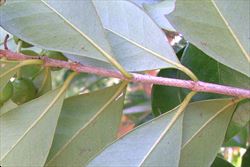
close-up of paler and duller leaf undersides (Photo: Sheldon Navie)

flowers in upper leaf forks (Photo: Sheldon Navie)
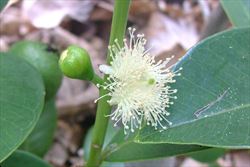
close-up of flower with numerous stamens (Photo: Sheldon Navie)
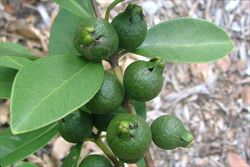
immature fruit (Photo: Sheldon Navie)
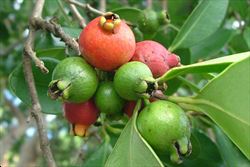
immature and mature fruit crowned with persistent sepals (Photo: Sheldon Navie)
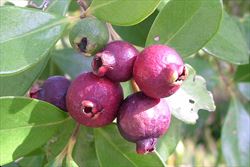
purplish-red mature fruit (Photo: Sheldon Navie)
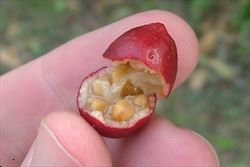
inside of mature fruit showing whitish pulp and seeds (Photo: Sheldon Navie)
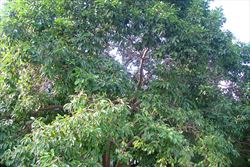
habit of the larger yellow cherry guava, Psidium cattleianum var. littorale (Photo: Sheldon Navie)
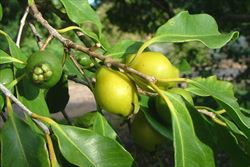
the yellow mature fruit of yellow cherry guava (Psidium cattleianum var. littorale). Also note the slightly larger leaves borne on longer stalks (Photo: Sheldon Navie)
Scientific Name
Psidium cattleianum Sabine var. cattleianum
Synonyms
Psidium cattleianum Sabine
Family
Myrtaceae
Common Names
Cattley guava, cherry guava, Chinese guava, pineapple guava, porpay, purple guava, purple strawberry guava, red cherry guava, red guava, red strawberry guava, small guava, strawberry guava
Origin
Native to South America (i.e. eastern Brazil and north-eastern Uruguay).
Cultivation
Red cherry guava (Psidium cattleianum var. cattleianum) has been widely cultivated as a garden ornamental and fruit tree in the warmer parts of Australia.
Naturalised Distribution
Widely naturalised, but scattered, in eastern Australia (i.e. naturalised in eastern Queensland and in the coastal districts of northern New South Wales). Also naturalised on Lord Howe Island, Norfolk Island and Christmas Island.
Widely naturalised overseas in tropical and southern Africa (e.g. Tanzania, South Africa and Swaziland), New Zealand, south-eastern USA (i.e. Florida), the Azores, the Seychelles, the Mascarenes (i.e. La Réunion and Mauritius) and on several Pacific islands (e.g. the Cook Islands, Hawaii, Fiji, French Polynesia, New Caledonia and Western Samoa).
Habitat
A weed of disturbed forests, forest margins, open woodlands, watercourses (i.e. riparian areas), wetlands and wetter grasslands in tropical and sub-tropical environments.
Habit
A shrub or small tree usually growing 1-3 m tall, but occasionally reaching up to 8 m in height.
Distinguishing Features
- a shrub or small tree growing 1-8 m tall.
- its dark green leaves (up to 8 cm long) are shiny and somewhat leathery in nature.
- its white flowers (15-25 mm across) have five petals and numerous stamens.
- these flowers are borne singly in the leaf upper forks.
- its fleshy fruit (2-3 cm across) turn purplish-red in colour when mature and are crowned with the some of the old flower parts.
Stems and Leaves
The younger stems are rounded, hairless (i.e. glabrous) or sparsely hairy (i.e. puberulous), and smooth in texture. Older stem have grey to reddish-brown peeling bark.
The simple leaves (4-8 cm long and 2.5-4.5 cm wide) are borne on short stalks (i.e. petioles) 4-10 mm long and are oppositely arranged along the stems. These leaves are oval (i.e. elliptic) to egg-shaped in outline (i.e. obovate) with shortly pointed tips (i.e. acute apices). They are dark green in colour, shiny in appearance, hairless (i.e. glabrous) and somewhat thick and leathery in nature.
Flowers and Fruit
The white flowers (15-25 mm across) are borne singly in the upper leaf forks (i.e. axils) on short stalks (i.e. pedicels) 3-7 mm long. They have five green sepals (3-4 mm long) and five white petals (about 5 mm long). They also have numerous white stamens with yellow anthers and an ovary topped with a single style. Flowering occurs mostly during spring and summer.
The fruit is a rounded (i.e. globose) fleshy berry that turns from green to purplish-red in colour as it matures. These berries (2-3.5 cm across) are crowned with the enlarged sepals (i.e. persistent calyx). They contain numerous seeds in a white pulpy flesh and are present during autumn and winter (i.e. from April to July).
Reproduction and Dispersal
This species reproduces mainly by seed, but also develops suckers.
Seeds are usually dispersed after being eaten by birds and other animals (e.g. feral pigs). They may also be spread in dumped garden waste.
Environmental Impact
Red cherry guava (Psidium cattleianum var. cattleianum) in regarded as an environmental weed in Queensland and New South Wales, and as a significant environmental weed on Lord Howe Island and Norfolk Island. It was recently listed as a priority environmental weed in at least one Natural Resource Management region.
This species is also a serious woody weed of sub-tropical island ecosystems in other parts of the world. Becuase of this it is listed in the Global Invasive Species Database (GISD), and is regarded to be among the top 100 of the world’s worst invasive alien species.
Legislation
This species is declared under legislation in the following states and territories:
- New South Wales: Class 3 - a regionally controlled weed. The relevant local control authority must be promptly notified of the presence of this weed and it must be fully and continuously suppressed and destroyed (on Lord Howe Island only).
- Western Australia: Unassessed - this species is declared in other states or territories and is prohibited until assessed via a weed risk assessment (throughout the entire state).
Similar Species
Red cherry guava (Psidium cattleianum var. cattleianum) is very similar to yellow cherry guava (Psidium cattleianum var. littorale), which can be easily distinguished by its slightly larger yellow fruit (about 4 cm across). Yellow cherry guava (Psidium cattleianum var. littorale) is also a larger tree, often greater than 3 m tall, with slightly larger leaves (5-10 cm long) that are borne on longer stalks (12-15 mm long).
Red cherry guava (Psidium cattleianum var. cattleianum) may also be confused with naturalised populations of guava (Psidium guajava) and Brazilian guava (Psidium guineense). These species can be distinguished by the following differences:
- red cherry guava (Psidium cattleianum var. cattleianum) has young branches that are rounded in cross-section (i.e. cylindrical) and relatively small purplish-red fruit (20-30 mm long). Its flowers are borne singly in the leaf forks (i.e. axils).
- guava (Psidium guajava) has young branches that are four-angled in cross-section (i.e. quadrangular) and relatively large yellow fruit (25-100 mm long). Its flowers are usually borne singly (occasionally in threes) in the leaf forks (i.e. axils).
- Brazilian guava (Psidium guineense) has young branches that are almost rounded in cross-section (i.e. sub-cylindrical) and relatively small yellow fruit (10-25 mm long). Its flowers are usually borne in threes (occasionally singly) in the leaf forks (i.e. axils).
It can also be confused with the native guava (Rhodomyrtus psidioides), which has flowers in larger clusters and smaller fruit (usually less than 2 cm across).

